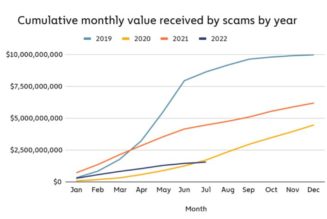In Q2 2022, Kaspersky solutions detected 40,788 new modifications of miners. According to Kaspersky Security Network data, in the African region, the number of home users affected by cryptominers in Q2 of 2022 decreased slightly compared to the previous quarter.
However, the possibility of a surge in cryptomining attacks persists and could be directly correlated to cryptocurrency exchange rates.
What is Crypto-Mining?
Cryptomining is a process during which users mining cryptocurrencies utilise computers, data, codes, and calculations to validate cryptocurrency transactions and earn cryptocurrency as compensation for their work.
Cryptomining is highly resource-consuming and hence expensive to do, which is why cybercriminals seek access to others’ machines to conduct mining on them.
Attackers can use compromised devices to generate cryptocurrency without the device owners’ knowledge. They can steal resources, for example, by sending endpoint users a legitimate-looking email that encourages them to click on a link which runs a code that places a cryptomining script or program on the victim’s computer.
Another method is to inject a script on a website or an ad that is delivered to multiple websites. Once victims visit the website or the infected ad pops up in their browsers, the script automatically executes. No code is stored on the victims’ computers.
Notable Attacks
In 2019, eight separate apps that secretly mined cryptocurrency with the resources of whoever downloaded them were removed from the Microsoft Store. In 2018, cryptojacking code was discovered within the Los Angeles Times’ Homicide Report page. Also in 2018 the CoinHive miner was found to be running on YouTube Ads through Google’s DoubleClick platform.
In the African regions there was a downward trend in cryptomining attacks, however, in South Africa the dynamics were multidirectional. The number of attempts by attackers to run cryptominers on home users’ machines decreased by 11% in Q2 2022 compared to Q1, yet, the number of home computers that were affected by cryptomining software increased by 2% over the same time period.
In Nigeria, the number of attempts to run cryptominers on home computers decreased by 16% in Q2 2022 compared to Q1, and the number of computers affected by cryptominers decreased by 10%. In Kenya, there was a milder decrease: 3% for attempts to run cryptominers on home machines and 6% for the affected computers.
“Before, cryptomining attacks were primarily an issue for endpoints, targeting desktops and laptops, sometimes – Android smartphones. Today, cryptojacking is expanding to include servers, network, and even IoT devices. Servers are usually higher powered than ordinary PCs and allow for greater mining capacity,” comments David Emm, Principal Security Researcher at Kaspersky.
“We see different levels of mining activity in different regions – this is because of different levels of cryptocurrency adoption in countries, but also because of the fluctuations of cryptocurrency exchange rates. Once crypto rises in value, the activity of attackers using miners increases.”
By Staff Writer.










Tagged: crypto mining, Crypto news, Cryptocurrency Africa, Cryptomining Africa, cybersecurity, Cybersecurity South Africa, Finance, IT News, Kaspersky, latest tech news, Security, tech news, technology news, Top Stories